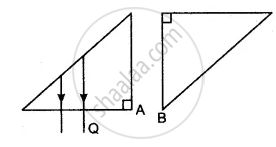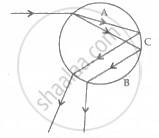Advertisements
Advertisements
प्रश्न
Answer the following question.
Why is prism binoculars preferred over traditional binoculars? Describe its working in brief.
उत्तर
- Traditional binoculars use only two cylinders. Distance between the two cylinders can’t be greater than that between the two eyes. This creates a limitation of the field of view.
- A prism binocular has two right-angled glass prisms that apply the principle of total internal reflection.
- The incident light rays are reflected internally twice giving the viewer a wider field of view. For this reason, prism binoculars are preferred over traditional binoculars.
Working:

Prism binoculars
- The prism binoculars consist of 4 isosceles, right-angled prisms of a material having a critical angle less than 45°.
- The prism binoculars have a wider input range compared to traditional binoculars.
- The light rays incident on the prism binoculars, first get total internally reflected by the isosceles, right-angled prisms 1 and 4.
- These reflected rays undergo another total internal reflection by prisms 2 and 3 to form the final image.
APPEARS IN
संबंधित प्रश्न
Which colour of light has a higher critical angle? Red light or green light.
Angle of deviation is the angle which the ______ ray makes with the direction of ______ray.
What is total internal reflection?
Total internal reflection occurs only when a ray of light passes from a ______ medium to a ______ medium.
(i) Define critical angle.
(ii) State one important factor which affects the critical angle of a given medium.
Define critical angle for a given medium.
How does a ray of light bend when it travels from denser to rarer medium.
If a ray of light passes from medium I to medium II without any change of direction, what can be said about the refractive indices of these media (angle I is not 0)?
What is meant by the term ‘critical angle’?
The adjacent diagram shows two right-angled isosceles prisms A and B. Complete the diagram to show the path of rays P and Q emerging out of the prism B. What principles have you used to complete the diagram?

Choose the correct option.
Consider the following phenomena/ applications: P) Mirage, Q) rainbow, R) Optical fibre and S) glittering of a diamond. Total internal reflection is involved in
Choose the correct option.
Angles of deviation for extreme colours are given for different prisms. Select the one having maximum dispersive power of its material.
Which of the following is not involved in formation of a rainbow?
Answer the following question.
Explain ‘mirage’ as an illustration of refraction.
The angle of minimum deviation produced by a thin glass prism in air is 'δ'. If that prism is immersed in water, the angle of minimum deviation will be ______.
( aμg = refractive index of glass w.r.t, air aμw = refractive index of water w.r.t. air)
Optical fibre communication uses the principle of ______.
A bundle of glass threads, each of which is capable of transmitting messages using light waves is called ______.
What are the conditions to achieve total internal reflection?
Write any two uses of total internal reflection.
What are the examples of total internal reflection in nature?
A ray of light incident at an angle θ on a refracting face of a prism emerges from the other face normally. If the angle of the prism is 5° and the prism is made of a material of refractive index 1.5, the angle of incidence is ______.
State the condition under which total internal reflection occurs. Give the mathematical expression for total internal reflection.
Observe the given figure of the raindrop and answer the following questions:

- Label A and B of the given diagram. Why colour will deviate most.
- Name the phenomenon shown in label C.
A given ray of light suffers minimum deviation in an equilateral prism P. Additional prism Q and R of identical shape and of the same material as P are now added as shown in the figure. The ray will now suffer ______.

Small air bubbles rising up a fish tank appear silvery when viewed from some particular angle is due to the ______.
